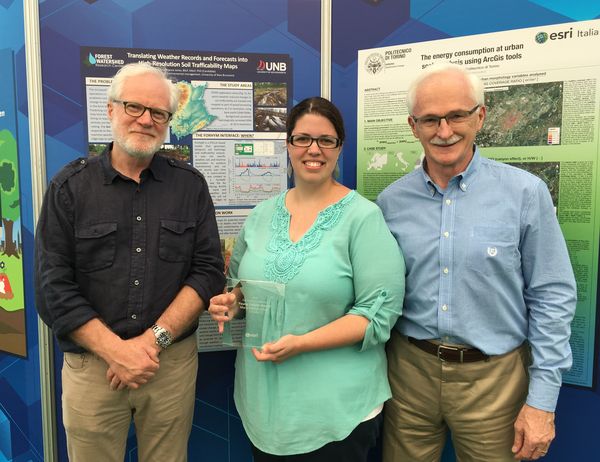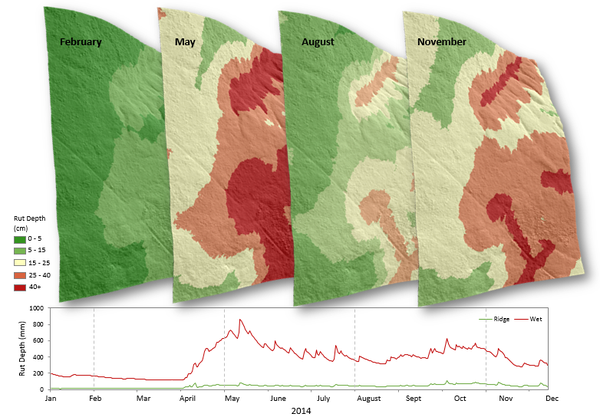An Esri Young Scholar’s Take On the Esri User Conference Experience
Over 16,000 people attended the Esri User Conference in San Diego at the end of June. Among them was Marie-France Jones, selected from among 42 applicants as Canada’s 2016 Esri Young Scholar (EYS). She was one of two dozen Esri Young Scholars from around the world who won the opportunity to attend the Esri Education GIS Conference and Esri User Conference.

I interviewed Marie-France to learn more about her experiences as an EYS.
KA: What were your overall impressions of the Esri UC and Education GIS conference?
MFJ: The Esri User Conference and Education Conference were just amazing! Being given the opportunity to attend both of them was great. I didn’t realize how big of an event it would be until I got to San Diego. Initially, I attended the Education Conference which focused on using ArcGIS in secondary and post-secondary settings. The Education Conference provided a personal learning experience while also showing me new applications for GIS within the secondary school system. I was definitely amazed at what middle school aged children can accomplish with the new ArcGIS tools. The main User Conference just blew me away by its grandeur. I’ve never been to a conference with over 15,000 people before. I was amazed at all of the ingenuity and technology presented at the conference.
KA: Were there any sessions that you found particularly useful or interesting?
MFJ: I gravitated towards specific types of sessions in both conferences. In the Education Conference, I went to a lot of the secondary school sessions. I was fascinated with what younger students are capable of achieving given the opportunity and available technology. There was a lot of talk about GeoMentors and their impact on how younger students can learn in this field. In the main User Conference, I focused on the sessions dealing with temporal modeling, flood mapping and drone technology. Our centre is incorporating drone technology into some of our newer projects, and I absorbed as much information from those sessions as I could. They were extremely useful to me, providing helpful hands-on tips as well as great contacts.
KA: Esri Canada recently launched the GIS Ambassadors program, which is similar to the GeoMentors program in the U.S. Now that you’ve seen the impact GIS professionals can have in the classroom, is this something you see yourself getting involved in?
MFJ: For sure, I would like to share my knowledge with students who are looking to learn more about GIS. Having spoken to a few teachers here in the Maritimes, I know that more access to GIS and GIS mentors is greatly desired. Canadian K-12 schools should definitely implement more GIS, and I’m definitely on board with helping out!
KA: Esri Young Scholars come from around the world. How did you feel meeting the other students?
MFJ: Getting to meet other young scholars from around the world was really beneficial! I met interesting people from different cultures and research fields, which I enjoyed because of my Forestry and Science background. All of the young scholars ranged in field of study: environmental sciences, architecture, social science and medicine. It really put into perspective how vastly applicable GIS really is.
KA: You said your background is in forestry. Why did you choose this field?
My background in forestry stems from my interest in plants and from a love for nature. During my undergrad (Bachelor of Science in Forestry), I loved plant physiology and morphology and that interest has kept me in this field. I also have a Master of Science in Forestry. I’m currently a PhD Candidate in Forestry at the University of New Brunswick in Fredericton, New Brunswick. Over the years, opportunities have presented themselves, and I find myself identifying more as a soil and hydrology scientist because most of my research experience in learning and teaching revolves around those topics.
KA: Can you tell me more about the project you submitted for the EYS competition (Translating Weather Records and Forecasts into High-Resolution Soil Trafficability Maps)?
MFJ: My project focuses on connecting temporal outputs to spatial mapping, specifically to predict soil trafficability, which is the soil’s ability to support machine traffic. The goal is to help limit the impact of heavy machine operations on soils, such as soil rutting, displacement, and compaction. The temporal side is a STELLA-based model that generates soil hydrology and trafficability outputs at any desired time interval (daily-yearly). The spatial model integrates those results into an ArcGIS ModelBuilder model, which generates potential rut-depth from ridge tops to valleys. At the moment, it utilizes a DEM-derived cartographic depth-to-water index to extrapolate the results over the terrain. The importance of this research is to show how potential rut depth incurred by forest operations can vary throughout the year based on soil moisture, which is essential for reducing operational damage to soils, limiting the impact on the forest and reducing costs associated with forest operations by optimizing location and timing of harvesting.

KA: What are you hoping to do after graduation?
After graduation, I’m on the fence about what I would like to do and where. One part of me loves the academic world and would like to stay in this setting and teach. I have a Diploma in University Teaching, and it would be great to transfer the knowledge that I’ve accumulated over my tenure as a graduate student to undergrads at the university and college level. We also work with younger students from time to time, running science fair and Envirothon prep. I’ve enjoyed working with young students and helping them discover new things about the environment around them. On the other hand, I enjoy working on different research projects. My PhD has enabled me to delve deeper into the GIS world, and I’d love to continue to work within this field. It has vast application to so many fields and would prove to be an interesting future career.
KA: Any final thoughts on being an Esri Young Scholar?
I am extremely grateful to Esri Canada staff and judges for selecting me for this wonderful opportunity. The Esri Canada staff at the conference made the experience so amazing, and I’m sincerely grateful to have met with Brent Hall (Director, Education and Research) and Alex Miller (President). The whole week was just a whirlwind of amazing sights, cutting-edge technology and informative sessions.
